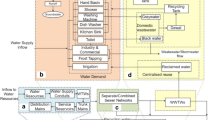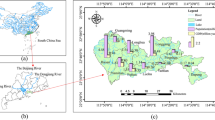Abstract
A revised concept for urban water metabolism (UWM) is presented in this study to address the inadequacies in current research on UWM and the problems associated with the traditional urban water metabolic process. Feedback loops can be analyzed to increase the water environmental carrying capacity (WECC) of the new urban water metabolism system (UWMS) over that of a traditional UWMS. An analysis of the feedback loops of an UWMS was used to construct a system dynamics (SD) model for the system under a WECC restriction. Water metabolic processes were simulated for different scenarios using the Tongzhou District in Bei**g as an example. The results for the newly developed UWM case showed that a water environment of Tongzhou District could support a population of 1.1926 × 106, an irrigation area of 375.521 km2, a livestock of 0.7732 × 106, and an industrial value added of ¥193.14 × 109 (i.e. about US$28.285× 109) in 2020. A sensitivity analysis showed that the WECC could be improved to some extent by constructing new sewage treatment facilities or by expanding the current sewage treatment facilities, using reclaimed water and improving the water circulation system.
Similar content being viewed by others
References
Chai Y. Study on WECC based on water metabolism system-—Tongzhou district as an example. Dissertation for the Master Degree. Bei**g: Bei**g Normal University, 2009. (in Chinese)
Hermanowicz W S, Takashi A. Abel wolman’s ‘The Metabolism of Cities’ revisited: a case for water recycling and reuse. Water Science and Technology, 1999, 40(4–5): 29–36
Tambo N. Hydrological cycle and urban metabolic system of water. Water Wastewater Engineering, 2002, 28(6): 1–5
Yan J S, Wang M Z. The problems of water environment in the urban and their eco-essence. Modern Urban Research, 2005, (4): 7–9 (in Chinese)
**ong J Q, Yan T, Wang X C. The mechanism and model of immunity on the urban water system. Journal of **’an University of Architecture and Technology, 2006, 38(6): 746–750 (in Chinese)
Song X S, Wang C S, Wang Y H. Problems of water environment in China’s urbanization process. Science and Technology Review, 2004, 6(2): 29–32 (in Chinese)
Newman PWG. Sustainability and cities: extending the metabolism model. Landscape and Urban Planning, 1999, 44(4): 219–226
Fischer-Kowalski M. Society’s metabolism the intellectual history of materials flow analysis. Part I: 1860–1970. Journal of Industrial Ecology, 1998, 2(1): 61–78
Huang S L, Lee C L, Chen C W. Socioeconomic metabolism in Taiwan: emergy synthesis versus material flow analysis. Resources, Conservation and Recycling, 2006, 48(2): 166–196
Kennedy C A, Cuddihy J, Engel Yan J. The changing metabolism of cities. Journal of Industrial Ecology, 2007, 11(2): 43–59
Kennedy C, Pincetl S, Bunje P. The study of urban metabolism and its applications to urban planning and design. Environmental Pollution, 2011, 159(8–9): 1965–1973
Newcombe K, Kalma J D, Aston A R. The metabolism of a city: the case of Hong Kong. Ambio, 1978, 7(1): 3–15
Warren-Rhodes K, Koenig A. Escalating trends in the urban metabolism of Hong Kong: 1971–1997. Ambio, 2001, 30(7): 429–438
Zhang Y, Yang Z F, Yu X Y. Evaluation of urban metabolism based on emergy synthesis: a case study for Bei**g (China). Ecological Modelling, 2009, 220(13–14): 1690–1696
Caffrey J M. Production, respiration and net ecosystem metabolism in U.S. estuaries. Environmental Monitoring and Assessment, 2003, 81(1–3): 207–219
Caffrey J M. Factors controlling net ecosystem metabolism in U.S. estuaries. Estuarie, 2004, 27(1): 90–101
Hall M H P. A preliminary assessment of socio-ecological metabolism for three neighborhoods within a rust belt urban ecosystem. Ecological Modelling, 2011, 223(1): 20–31
Marc J R, Paul A M, Richard D K. The effect of freshwater inflow on net ecosystem metabolism in Lavaca Bay, Texas. Estuarine, Coastal and Shelf Science, 2006, 68(1–2): 231–244
Mead L H, Wiegner T N. Surface water metabolism potential in a tropical estuary, Hilo Bay, Hawai’i, USA, during storm and non-storm conditions. Estuaries and Coasts, 2010, 33(5): 1099–1112
Zhang Y, Yang Z F, Fath B D. Ecological network analysis of an urban water metabolic system: model development, and a case study for Bei**g. Science of the Total Environment, 2010, 408(20): 4702–4711
Author information
Authors and Affiliations
Corresponding author
Rights and permissions
About this article
Cite this article
Zeng, W., Wu, B. & Chai, Y. Dynamic simulation of urban water metabolism under water environmental carrying capacity restrictions. Front. Environ. Sci. Eng. 10, 114–128 (2016). https://doi.org/10.1007/s11783-014-0669-6
Received:
Accepted:
Published:
Issue Date:
DOI: https://doi.org/10.1007/s11783-014-0669-6




